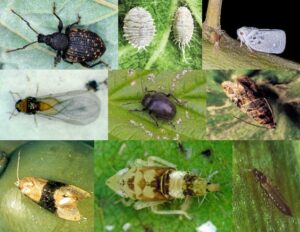Overview of mites, lice, beetles, cicadas, worms, caterpillars and moths. Some of these critters eat from the plant, others infect the plant by carrying a bacterium or virus, still others cover the plant with spider mites.
| French name | English name | pathogen | course of the disease | characteristic diseased part | Main features | Status |
|---|---|---|---|---|---|---|
| cochenille grise de la vigne | mealy bug | mealybug: Phenococus hystrix | secretes kind of honey on leaf, breeding ground for fungus; can also infest grape cluster | leaf | white downy wax flakes; usually minor damage | |
| Flavescense dorée | Grapevine yellows; leafhopper | Cicada: Scaphoideus titanus | Bacterially infected cicada (Scaphoideus titanus) transmits Phytoplasma vitis. | leaf | leaf discolours, hardens and rolls up; plant dies | |
| thrips | thrips | Insect belonging to the fringed winged insects (thysanoptera): thrips fuscipennis | Sucks at the leaf | leaf | small black spots; little damage | |
| tétranyque tisserand ou araignée jaune | red mite; two-spotted mite; two spotted red spider mite; yellow mite | mite: Tetranychus urticae or the panonychus ulmi | Sucks at the leaf | leaf | light dots on the leaf | |
| Phytopte de la vigne; erinose | Grape leaf blister mite; | Eriophyes vitis; colomerus vitis | Mites form galls on leaves | leaf | Green bumps on leaves and deformities | |
| Grape vine bud mite | Eriophyes vitis; colomerus vitis (same species as above, only the bud mite shows different behaviour: attacks buds and not leaves) | mites are nesting in the buds | buds | Smaller leaves; dead buds | not in France? | |
| La cochenille farineuse de vigne | Citrus Mealy Bug | mealybug: Planococcus citri: Pseudococus citri | secretes type of honey on leaf, breeding ground for fungus; can also infest grape cluster | leaf | white downy wax flakes; usually minor damage | |
| Otiorhynque de la vigne; charançon noir de la vigne | black vine weevil | Insect, beetle: Otiorhynchus sulcatus | larva eats root, leaf and shoot | leaf | leafs with holes | |
| Phytopte de l'acariose de la vigne | Grape leaf rust mite | mite: Calepitrimerus vitis; Epitrimerus vitis; Phyllocoptes vitis | Mites form discolourations on leaves | leaf | Green bumps on leaves and deformities | |
| Cochenille floconneuse | Cottony vine scale | scale insect: Pulvinaria vitis | sucks up juices and excretes stringy honeydew | leaf and stem | sticky white spinel on leaf and stem; little damage | |
| Cicadelle blanche; Cicadelle pruineuse | Citrus flatid planthopper | Cicada: Metcalfa Pruinosa | Cicada sucks plant juices | leaf and stems | white waxy excretion over the plant by the larvae | |
| tordeuse; ver de la grappe; eudemis | european vine moth | Moth: Lobesia botrana; Polychrosis botrana; Eudemis botrana | Damage and later gouging of grapes | leaf, grape | ||
| tordeuse; ver de la grappe; cochylis | vine moth | moth: Clysia (Cochylis) ambiguella; Eupoecilia ambiguella | Damage and later gouging of grapes | leaf, grape | ||
| Gribouri; écrivain | Western grape rootworm | beetle: Bromius obscurus | Eat the leaf by nibbling the upper epidermis; this is how marks appear on the leaves | leaf, but also tendrils | marks on the leaves | Almost disappeared in France |
| Court noué | Xiphinema index (worm); dagger nematode. Grape fan leave (virus) | Worm: Xiphinema index; Xiphinema diversicaudatum | virus-infected worm eats root tips and transmits virus; Xiphinema index transmits fan leave virus and Xiphinema diversidaudatum the Arabic Mosaic Virus | Leaf, but also stems and grapes | Decolourisation of leaves in fan shape | |
| Phylloxera | Phylloxera vine louse | Aphid: Daktulosphaira vitifoliae (formerly Phylloxera Vastatis) Phylloxera Vastatis; | affects roots | roots (resides as aphids also on leaves) | Little foliage and browning of leaves; plant dies. | New grape varieties on grafting vines solved the problem. |

